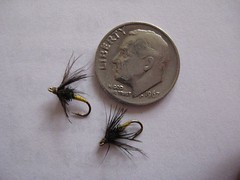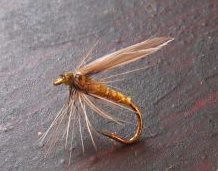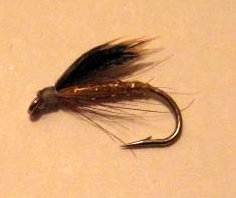Old Fly Patterns
Inspired by easy access to old angling literature via Google Books, I've been tying some British patterns from the 19th century. Here is one I'm anxious to get in the water:

from Ewen M. Tod, "Wet Fly Fishing, Treated Methodically"
London: Sampson Low, Marston (1907).
p. 236:
".... During the first week of May, in 1877,
I was busily fishing "the Tummel," with
frost and snow all round me.....
Curiously, even now, I remember that
my best fly was one I dressed with the
neck hackle-feather of the cock starling,
but with the addition of a mere dot of "
peacock herl," placed immediately under
the hackle itself. I presume that it gives
additional lustre to this imitation, and so
attracts the trout, especially in cold dark
days, when he is not inclined to show his
nose on the surface of the water. "
Flies pictured:
hook: wet fly hook #14 - 18
abdomen: waxed primrose silk
thorax: peacock herl.
collar: starling
The Greenwell's Glory is a 19th century pattern from the north of England. The pattern has a lot of history; here is an extensive article. It looks like a good match for the Blue Winged Olive, a very important early and late season hatch here in the Willamette Valley. Here are a couple of variations:


from Tod, page 210.
"GREENWELL'S GLORY.
Body. — The yellow tying silk, waxed with cobbler's wax,
to impart to the body a greenish-yellow hue. This is ribbed
over with yellow gimp, or finest gold wire.
Hackle— Coch-y-Bonddhu.
Wings. — Blackbird, tied in a bunch, and split.
Season. — April, May, June, and September ; in fact, it is
the most valuable and generally useful of all the wet flies
known to the author, who obtained the pattern direct from
the Rev. Canon Greenwell himself, so that it is authentic."

from Ewen M. Tod, "Wet Fly Fishing, Treated Methodically"
London: Sampson Low, Marston (1907).
p. 236:
".... During the first week of May, in 1877,
I was busily fishing "the Tummel," with
frost and snow all round me.....
Curiously, even now, I remember that
my best fly was one I dressed with the
neck hackle-feather of the cock starling,
but with the addition of a mere dot of "
peacock herl," placed immediately under
the hackle itself. I presume that it gives
additional lustre to this imitation, and so
attracts the trout, especially in cold dark
days, when he is not inclined to show his
nose on the surface of the water. "
Flies pictured:
hook: wet fly hook #14 - 18
abdomen: waxed primrose silk
thorax: peacock herl.
collar: starling
The Greenwell's Glory is a 19th century pattern from the north of England. The pattern has a lot of history; here is an extensive article. It looks like a good match for the Blue Winged Olive, a very important early and late season hatch here in the Willamette Valley. Here are a couple of variations:


from Tod, page 210.
"GREENWELL'S GLORY.
Body. — The yellow tying silk, waxed with cobbler's wax,
to impart to the body a greenish-yellow hue. This is ribbed
over with yellow gimp, or finest gold wire.
Hackle— Coch-y-Bonddhu.
Wings. — Blackbird, tied in a bunch, and split.
Season. — April, May, June, and September ; in fact, it is
the most valuable and generally useful of all the wet flies
known to the author, who obtained the pattern direct from
the Rev. Canon Greenwell himself, so that it is authentic."



2 Comments:
Thanks for the pictures and insight.
Aloha,
Keahi
these are amazing. i love the idea of reproducing historical patterns. next is reproducing historical angling wardrobes and gear.
Post a Comment
<< Home